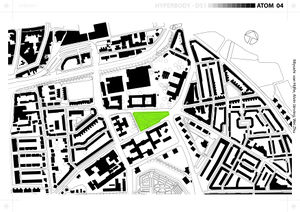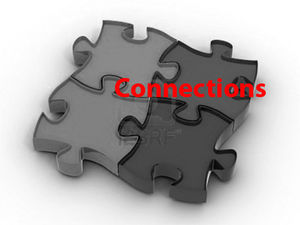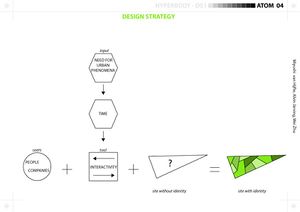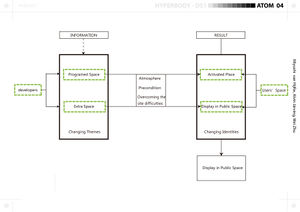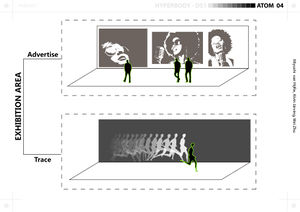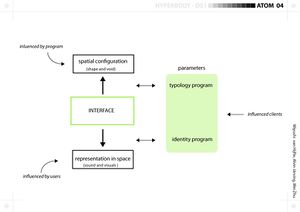atom04:'''PHASE 1'''
Contents |
PHASE 1 - DESIGN BRIEF
CONTEXT
Site
Site is located between the TU Delft Campus and the Old Town. see photos, maps, neighbours
We analized zoningplans from the municipality of Delft. We analized the site in variours scales see more
MISSING DIAGRAM: THE CAMPUS SCALE SITUATION BEING NOT ON THE TRAFFIC ARTERY
CONCLUSION
The zoning plan describes the need for the site to become the link between the city and the campus. To achieve that there is a need for the site to become more than its location per se promises. The link between the city and campus has to have a wider public meaning, the site has to start interrupting the local light-traffic flows to achieve needed critical mass. The lacking of clear character must be replaced with evolving identity. It has to be strongly differentiating and not counting on program that might change rapidly. To clear the problems of invisibility the site needs to become closely tied to it neighbours. To attract the functions that will improve the site's relevance in the scale of Delft, the site needs to be contitioned for spatial affordance.
Actors
DIAGRAM MISSING THE RELATION BETWEEN DIFFERENT CLIENTS similR to that one:
USERS
mainly students ARCHIVE of interviews
CLIENTS
Delft Science Center, TU Delft, Food Gaterer, Bars, Clubs ARCHIVE of interviews
EXPERTS
validators of our design ARCHIVE of interviews
CONCLUSION
The users (mostly students) are consuming the public space character. Through that they are becoming the customers for the clients, the users can be seen as the amplifiers of the programme. The second group are the clients (TU Delft, Science centre, Food caterer) of the programmed space (commercial functions, exhibition, showroom,...)
OLD VERSION OF CLIENTS:
CONCEPT
Challenge
Our design challenge is to create a site with evolving identity which serves the spatial affordance of certain activities in dynamically changing programmatic context.
MISSING DIAGRAM updated design strategy... an update of the existing
Specialization
Site conditioning for identity. The site has to be conditioned to have a set of qualities that allow fixed character through desired activities. We are achieving these qualities through representational and spatial means. Our challenge is to manipulate the with the memory of the users to amplify activities.
the diagramm about the interface / miyushi
Project
Our Project is about the gradience between the private and public. The design effort lies in the transition space between the streetscape and the buildings. This concept creates the contrast between flexible buildings and the identity holding interface landscape.
We are looking for collaboration with other atoms in terms of private functions, buildings.
DIAGRAM NEEDS TO BE IMPROVED BASED ON THAT GUY:
References / Definitions
ARCHIVE of references, definitions and research
OLD MANIFESTO:
INTERVENTION
Process strategy
The first step of the process is the creation of the site plan with the renewed traffic scheme. According to that the borderlines of the private and public space will be proposed. The main effort of the work is located in the identity holding public and private interface design. The interface is created through the representational (the memory machine) and spatial means (transition space).
Memory Machine
The machine is collecting, processing and displaying data. The memory machine is a tactical tool to improve the local identity. This simple device can create spatial repetitions. It can replay moments according to the needed mood (passive representation) or according to the routines of the users to establish interactive relationship with the users (active representation). The machine has recording and replaying devices (sound, visuals) to point out the virtual representation of wanted situation. The representation can be processed with certain filters to improve the identity of the client. The pictures can be repainted according to specific mood of event or missing mood of the moment. The filters are dealing with the colouring, contrasting, shuffling, sharpening, blurring and proportioning the reality towards emotion.
The memory machine is a tactical tool to improve the site identity.
It replay 'translated' moments according to the needed mood at every moment.
The replayed moments are collected date from the users who are using the site.
the translation is done by a kind of filter what translate the monents into sounds and visuals.
The replaying of is a representation in space what will create a different 'mood'.
Thereby the representation is related/adjunct to time.
The time of replay will influences the experiences of the users.
This is controlled by the occupation of the site.
Transition space
The Border between the private and the public gives us a clear research theme on existing typologies. The becoming from private to public can (the levels and the sizes of the transition spaces) can be seen as parameters for the spatial affordance of desired program. The parametric model will be dealing with the measure of the void in terms of the porosity, transparency and permeability.

